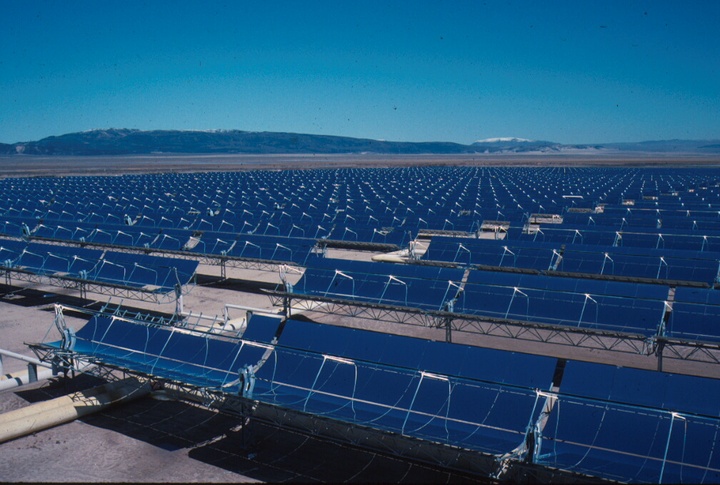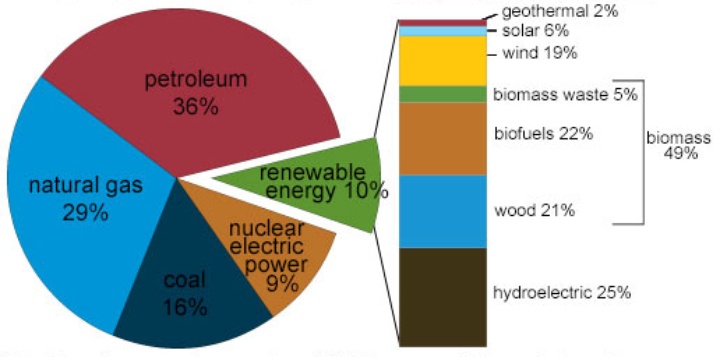Talk about cognitive dissonance. Last Tuesday, not-my-President signed orders rolling back pollution restrictions on coal-fired power plants, as if a swipe of a pen could magically revive the dying coal industry. Ain’t gonna happen. The U.S. is meanwhile being left in the dust by other countries that, long ago, saw the writing on the wall and invested in renewables.

Part of the one-third-gigawatt solar power complex in San Bernardino County (BLM)
Since overtaking the United States in 2010, China has been the world’s largest energy consumer. Last January, the Chinese government ordered cancellation of 104 coal projects which between them would have had a total capacity of 120 gigawatts. This is huge! It would be like canceling the equivalent of 40% of the Unites Sates’ total coal capacity of 305 gigawatts. Not incidentally, China has been the world’s leading installer of solar photovoltaics since 2013.
Worldwide: According to the World Economic Forum, in 2016, “Renewable energy generation reached a tipping point, data analyses show: the cost of generating electricity from renewable sources in the last 3 years fell to levels on par or below that of coal and natural gas.”
Denmark obtained 92 percent of its energy needs from imported oil in the 1970s. Today, 40 percent of its power comes from renewables, and it’s on track to reach 100 percent renewable electricity by 2035. In 2015, wind power (the country is blessed with high offshore winds) supplied 42 percent of Denmark’s electricity.
In India, the Minister of Energy said a year ago that his country was on track to deploy 100 gigawatts of solar power by 2022, claiming that a new coal plant would “give you costlier power than a solar plant.”
Worldwide: Paris-based REN21 (for the Renewable Energy Policy Network for the 21st Century) said recently that a quarter of the world’s power now comes from renewable energy.
In the UK (a country long dependent on coal), wind turbines generated more electricity than coal last year. The last of Britain’s coal power plants are scheduled to close down within the next five years.
Once the largest coal power plant in North America, Canada’s Nanticoke plant on Lake Erie is being converted to a solar power station after being closed down four years ago. It will generate 44 megawatts of solar power (1,000 megawatts = 1 gigawatt.)
99% of Costa Rica’s power came from renewables over a 100-day period in 2016. The country’s goal is to be fully carbon-neutral by 2021. It won’t be the first, though; Bhutan is actually carbon-negative, absorbing more carbon dioxide in its forests than it emits.
August 7, 2016 was a red-letter day for Scotland, when high winds resulted in 106% of its power needs being met by wind turbines.
Net-generation from renewable energy sources in Germany increased from 6.3% in 2000 to 34% in 2016. Like Scotland, Germany had a red-letter day, virtually all of its electricity coming from renewables on May 15, 2016.

U.S. electricity sources, 2015 (U.S. Energy Information Administration)
Meanwhile in the U.S., while the Federal government wants to put miners back to work in West Virginia (at whatever cost), states and municipalities are going their own way—leaving coal far behind.
In Texas, coal power generation dropped from 39% to 25% between January 2015 and May 2016.
Last December Las Vegas claimed to have met its goal of being powered entirely by renewable energy, following completion of the 100 megawatt Boulder Solar 1 power plant. (The claim has been challenged; Snopes says, “mostly true.”)
This year will see Google’s electricity needs coming entirely from renewables seven years after its far-sighted decision to buy all the electricity generated by a 114 megawatt wind farm in Iowa. Google say it’s the world’s largest corporate buyer of renewable energy.
And if you’re going to argue that we have no way to store renewable energy, you haven’t been following the news: Tesla’s $5 billion Nevada factory will produce half a million lithium ion batteries annually when complete in 2020. According to Tesla founder Elon Musk, 100 of such factories “could provide enough storage capacity to run the entire planet on renewables.”
A Final Word…

Plastics! There’s a great future in plastics!
By the way, if you’re wondering where all the good news about solar is coming from, I want to say one word to you. Just one word. (Benjamin: “Yes, sir?”) Perovskites. At this point, it looks as if perovskite solar panels will cost less than 20 cents per watt, compared to about 75 cents per watt for traditional silicon-based panels.
(Perovskite is a mineral composed of calcium titanate, easily mistaken for galena. According to Wikipedia, “Solar cell efficiencies of devices using these materials have increased from 3.8% in 2009 to 22.1% in early 2016…Traditional silicon cells require expensive, multistep processes, conducted at high temperatures (>1000 °C) in a high vacuum in special clean room facilities. Meanwhile, the organic-inorganic perovskite material can be manufactured with simpler wet chemistry techniques in a traditional lab environment.)
CLICK TO MANAGE